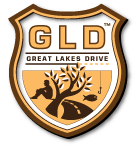Bark River and Tributaries
Bark River and Tributaries
Bark Bay Slough State Natural Area, Wisconsin
Bark River is classified a Class 1 trout stream by WDNR. This means that it is considered a high quality trout waters that have sufficient natural reproduction to sustain populations of wild trout, at or near carry capacity. Consequently, streams in this category require no stocking of hatchery trout. These streams or stream sections are often small and may contain small or slow-growing trout, especially in the headwaters.
Bark River Overview
The Bark River is a medium-sized spring-fed trout stream that flows north into Bark Bay. The entire river supports reproducing trout, including many migratory runs from Lake Superior, and has been classified as an outstanding resource water. Stream bottom types vary, with the lower reaches mostly sand, gravel and clay, while the upper reaches consist of mixed sand, gravel and boulders. The upper reaches have a steep gradient through a ravine. Large amounts of debris have accumulated along this portion of the stream, which, if large and woody, may enhance habitat (Pratt 1996). The area supports nesting and migratory waterfowl. One characteristic of the river is extensive wetlands about 2.5 miles from the lake. The river flows through an area of cedar and white pine. The Lake Superior Binational Program identified this river as important to the integrity of the Lake Superior ecosystem for rare communities.
The river empties into Bark Bay, which is bounded by Roman Point to the east and Bark Point to the west. Bark Bay has a beach dunes landscape, with extensive coastal wetlands that feature a bog. The bay supports submergent vegetation. The extensive wetlands provide high quality habitat for wading birds and waterfowl. Shorebirds use the shoreline. The Ainland@ fishery in the wetland and lagoon area is a varied community of primarily warm water fish species. Spawning migratory rainbow trout use this area and the Bark River. The nearshore waters of Lake Superior provide spawning habitat for both lake trout and lake whitefish. This area is subject to some development. Several cabins have been built on a long, narrow sand spit that separates the lagoons from the lake. The land in the area is in both state (Bark Bay Natural Area) and private ownership. The Lake Superior Binational Program has identified this area as important to the integrity of the Lake Superior ecosystem for coastal wetlands, rare communities, rare habitat, habitat unique to the Great Lakes and fish and wildlife spawning and nursery grounds. The coastal wetland evaluation identified Bark Bay as a priority wetland site (see discussion, above).
During survey work conducted as part of the coastal wetlands evaluation, three rare species of macroinvertebrates were found and overall taxa richness was moderate (5-24 species) (Epstein 1997). The survey noted that bank erosion and turbidity may be potential problems.
The water marked for higher production is located south of Lake Superior and 13. Bark River Rd is the closest rd and runs South and West of the river. Check access maps.
Specific Map
Source & More Detail
Wisconsin Trout Stream Maps
Wisconsin Public Access Maps
All content the property of WDNR

